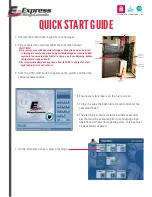
Bob Assistant - Reference Manual
2023-04-04 - Version 1.0
28
III.
Uplink payloads (Device to LoRaWAN server)
3.1.
Introduction
BoB ASSISTANT sends 4 types of messages:
LEARNING
,
REPORT
,
ALARM
and
STATE
. The payload for
each message has a different structure and each message type is identified with byte 0 (header).
•
LEARNING
occurs only during the Learning mode (during the first 7 days);
•
REPORT
is sent each 3 hours (default configuration);
•
ALARM
message is sent when anomaly level reaches XX% (25% default).
•
STATE
is sent when the measured equipment changes its state from ON to OFF or OFF to ON
(start/stop), when vibration test at startup fails, or when the device is turned on or off (with or
without flash erase).
STATE message is the first applicative payload sent by the device after power-on.
A javascript codec (ES5 and ES6) is provided to decode the frames sent by the device. It is available at
https://github.com/Watteco/Codec-BoBAssistant-Javascript
3.2.
LEARNING MESSAGE
3.2.1.
Payload structure
Evolutions compared to previous version of the device
are in red
in the following table
Byte
Definition /
codec
attribute
Value
(dec)
Real_Value
(dec)
Unit Range
Type
Comments
0
Header /
learning
108
const
N/A
hex=0x6C =>
l
earning header
1
Learning percentage /
learningpercentage
0~100 Value
%
[0,100]
integer
0-100: Percentage of the learning process
2
Vibration level (vl_1) /
vibrationlevel
0~127 Value
g
[0,127]
fl
oat
Vibration level measured
for the last sample of the current learning
stage
vl=(vl_1*128+vl_2+vl_3/100)/10/121.45;
The codec will calculate the maximum vibration level value and return it
in the
“
vibrationlevel
” attribute
The threshold of vibration level is 0.01g
3
Vibration level (vl_2) /
vibrationlevel
0~127 Value
4
Vibration level (vl_3) /
vibrationlevel
0~127 Value
5
Peak frequency index /
peakfrequencyindex
0~
256
Value+1
[0,
256
]
integer
float
Frequency index value with the highest vibration level measured
for the
last sample of the current learning stage
Frequency_index=Value+1;
The codec will calculate the Frequency index value and return it in the
“
peakfrequencyindex
” attribute
If
peakfrequencyindex
value is <128 then Peak frequency step =3,125Hz
and the corresponding peak frequency value is
Frequency_value=(Value+1)*FREQ_SAMPLING_ACC_LF/256
If
peakfrequencyindex
value is >= 128 then Peak frequency step =100Hz
and the corresponding peak frequency value is
Frequency_value=((Value & 0x7F)+1)*FREQ_SAMPLING_ACC_HF/256
The Frequency value is not calculated by the codec and must be
calculated by your web application.
6
Temperature /
temperature
0~127 Value-30
°C
[-30,97]
integer
Temperature measured during
the last sample of the current learning
stage
The Value is constrained to be with a range [-30,97]
The codec will calculate the temperature value and return it in the
“
temperature
” attribute
7
Learning type /
learningfromscratch
0~1
Value
boolean Learning from scratch or additional learning:
1: Learning from scratch;
0: Additional learning
8~39 FFT signal /
fft
[0;31]
0~127
g; Hz
float
float
float
FFT signal measured
for the last sample of the current learning stage
Value_g
=Value*vl/127; (see bytes 2-3-4 for vl value calculation)
The codec will calculate the g value and return it in the “
fft
” attribute
Frequency_hz
=(i+1)*FREQ_SAMPLING_ACC_HF/256 (i is the index of FFT
array, begins from 0, ends by 31, frequency step =100Hz)
The Frequency value is not calculated by the codec and must be
calculated by your web application.
See
for details on FREQ_SAMPLING_ACC_LF and FREQ_SAMPLING_ACC_HF
















































